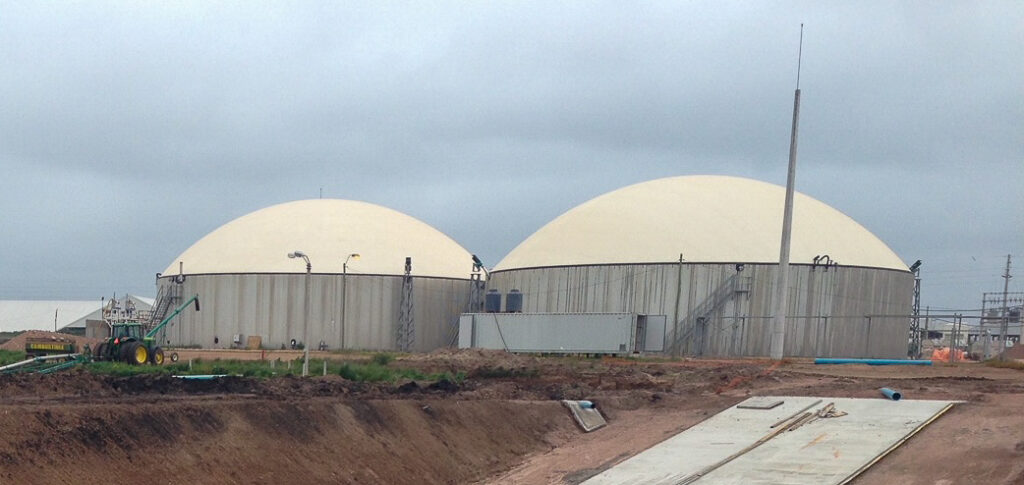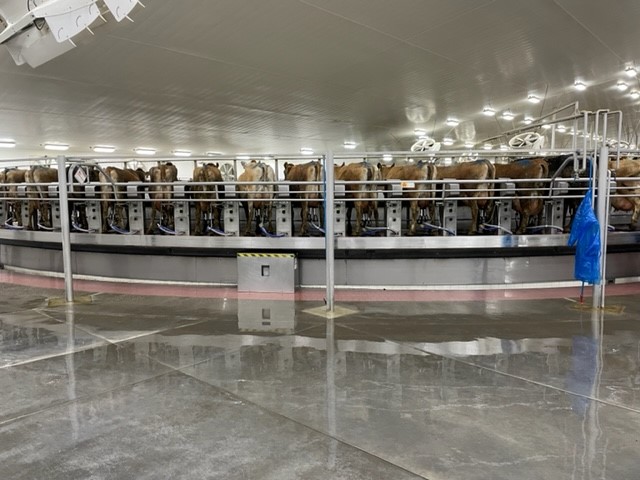
Carbon intensity (CI) is the the amount of greenhouse gases produced throughout the lifecycle of a fuel per unit of energy. The low carbon fuel standard (LCFS) is a rule that was enacted to offset the CI of conventional fuels such as gasoline or diesel fuel. Renewable natural gas (RNG) produced by anaerobic digestion (AD) of dairy manure is used as motor fuel in places like California, resulting in very favorable premiums because the CI score of RNG from dairy manure is very low compared to conventional fuels. When dairy manure is used as fuel for the AD process, it is imperative the manure is in a form most conducive to maximizing gas production.
Any due diligence process, whether you are an AD project developer or dairy producer, should involve an investigation of all sources of water added to manure, as this will affect total gas production and the costs to build and operate the AD plant—manure is fuel for the AD process and dilution of the fuel is undesirable. Dilution sources on dairies may include: parlor (milk house) water, parlor flushing, dumped waterers (cleaning), and process water required to clean manure equipment. Ultimately, the total solids (TS) content of the manure entering the AD plant is a composite of the manure TS plus all dilution sources. In essence, what goes in must come out—both in terms of volume and composition.
Why Does Water Matter?
Central to AD is the ability to reliably produce the maximum amount of biogas for the least cost—both in terms of capital and operating expenditures. To achieve this, digester developers prefer, and in most cases contractually specify, manure entering the digester conforms to certain specifications such as total solids (TS). TS is an indication of manure dilution. Minimal dilution is preferred since more dilution requires larger tanks, and therefore higher capital costs because the water must be stored for the design retention time. Dilution also increases operating expenses because the additional water, which contains minimal or no biogas producing potential, must be heated to the AD operating temperature. TS in a manure supply agreement can range anywhere from a minimum of 6% upwards to 10%.
 How Much Water?
How Much Water?
The process of milking cows requires a certain amount of freshwater. Some freshwater is used for equipment hygiene and milk cooling. After all, we are talking about harvesting, handling, and storing fresh food products. Water is also used to cool cows where environmental conditions dictate.
Manure (including urine) TS from lactating cows depends on factors such as animal: age, breed, milk production, and stage of lactation, to name a few, with 10 to 12% being common. To be clear, this is classified as excreted manure—that is, manure that contains no parlor wash water, cooling water, dumped waterers, leaky hoses, etc.
The amount of freshwater used on a per cow basis varies greatly and is very dependent on parlor type, geographic location, and management practices. A study by Harner et al (2015) reported the average milking center water usage was 11.2 gallons/cow/day. If we were to assume manure production at a rate of 150 pounds/cow/day at a TS of 12%, the net result is a composite manure TS of 7.4%. A study by Williams (2009) that surveyed water usage on 780 dairies found 16 gallons/cow/day to be “reasonable”. Water usage at this level translates to a composite manure TS of 6.4%. Keep in mind, that this does not include spilled waterers, parlor and holding pen flushing, wash pens, etc. So, before any additional water is added, manure TS is pushing the 6% lower TS limit specified by most AD developers.
Why More Water?
Water is commonly used to convey manure away from barns (flush flumes) or to clean manure from alleys and convey it from barns (full alley flush). These systems add substantial amounts of additional dilution water relative to manure inputs. Some flush flumes operate 24 hours/day at 1,000 GPM or higher. This is most likely not freshwater, but rather recycled water from a second or third-stage manure holding pond. This is known as open-loop water recycling. Adding water in this manner can drive TS down to less than 3% and with substantial increases in volume, which leads to substantial increases in digester size and operating costs.
Dilution water requirements due to manure conveyance can be reduced by using closed-loop water recycling, which will be discussed in Part 2 of this series on Dairy Manure Digestion and Dilution.
How to Get a Handle on Water?
Knowing the composition of digester influent is key to designing an AD system and ultimately project success. TS specifications being written by AD developers and agreed to by dairies push the limits of what is practical. The TS content of dairy AD influent depends on the physical properties of the manure in addition to a full accounting of all dilution water sources. Before specifying manure influent TS or accepting a specification, the amount of manure and freshwater entering the AD system should be studied. Manure testing of the candidate diary is preferred as it gives a direct measure of manure TS. Water meters are also an option in the event the water can be attributed to being combined with manure. Referencing water usage and manure composition data for dairies of similar size, management practices, etc. in a similar climate is the next best option. Most of all, remember, dairy AD influent is more than manure.
If you have questions or would like more information on how Settje could assist with your dairy manure digestion, contact your local Settje consultant. If you don’t have a Settje consultant, you can contact us directly.

